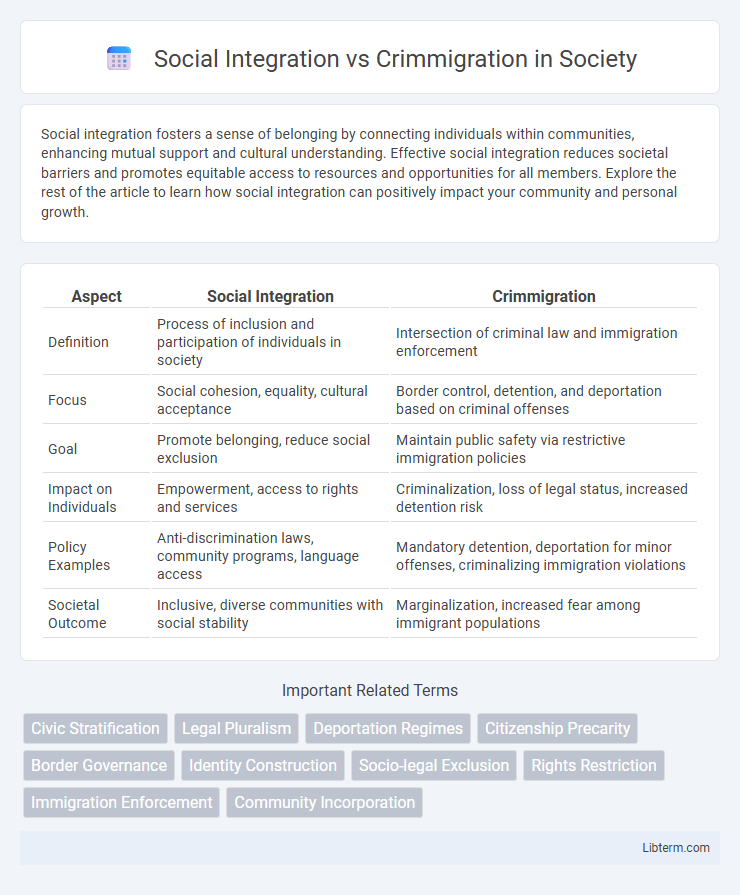Social integration fosters a sense of belonging by connecting individuals within communities, enhancing mutual support and cultural understanding. Effective social integration reduces societal barriers and promotes equitable access to resources and opportunities for all members. Explore the rest of the article to learn how social integration can positively impact your community and personal growth.
Table of Comparison
| Aspect | Social Integration | Crimmigration |
|---|---|---|
| Definition | Process of inclusion and participation of individuals in society | Intersection of criminal law and immigration enforcement |
| Focus | Social cohesion, equality, cultural acceptance | Border control, detention, and deportation based on criminal offenses |
| Goal | Promote belonging, reduce social exclusion | Maintain public safety via restrictive immigration policies |
| Impact on Individuals | Empowerment, access to rights and services | Criminalization, loss of legal status, increased detention risk |
| Policy Examples | Anti-discrimination laws, community programs, language access | Mandatory detention, deportation for minor offenses, criminalizing immigration violations |
| Societal Outcome | Inclusive, diverse communities with social stability | Marginalization, increased fear among immigrant populations |
Understanding Social Integration: Definitions and Goals
Social integration involves the process by which immigrants and minorities become fully incorporated into the social, economic, cultural, and political life of the host society, aiming to achieve equal opportunities and social cohesion. It emphasizes access to education, employment, housing, and community participation to foster a sense of belonging and reduce social exclusion. Understanding social integration requires distinguishing it from crimmigration, which criminalizes immigration enforcement and often undermines immigrant inclusion by conflating criminal activity with immigration status.
The Concept of Crimmigration: Origins and Evolution
The concept of crimmigration merges criminal law and immigration law, highlighting how enforcement practices target immigrants through both legal frameworks. Originating in the early 2000s, crimmigration evolved as states increased border security and criminalized immigration violations, reflecting policy shifts after events like 9/11. This hybrid legal approach intensifies social exclusion and complicates immigrant integration by intertwining criminal justice with immigration enforcement.
Key Differences Between Social Integration and Crimmigration
Social integration emphasizes the inclusive process of incorporating immigrants into the social, economic, and cultural fabric of a host society, promoting equality and community participation. Crimmigration merges criminal law and immigration enforcement, focusing on control and exclusion by treating immigration violations as criminal offenses. The key difference lies in social integration's goal of fostering belonging and access, whereas crimmigration prioritizes deterrence and punishment.
Historical Context: Immigration Policies and Social Cohesion
Historical immigration policies have significantly shaped the dynamics between social integration and crimmigration, often prioritizing control and exclusion over cohesion. Laws such as the Immigration Act of 1924 in the United States institutionalized racial and ethnic barriers, fostering social divisions and marginalizing immigrant communities. These policies have influenced contemporary debates by intertwining criminal justice systems with immigration enforcement, thereby complicating pathways to social integration and undermining community trust.
Legal Frameworks: From Integration to Criminalization
Legal frameworks shape the balance between social integration and crimmigration by determining whether policies prioritize inclusion or enforcement. Integration-focused laws promote access to education, healthcare, and employment for immigrants, fostering social cohesion and protection of rights. Conversely, crimmigration policies merge immigration control with criminal justice measures, often criminalizing migration and restricting immigrant rights through detention and deportation.
Societal Impacts of Crimmigration Policies
Crimmigration policies, which merge immigration enforcement with criminal law, intensify social exclusion and hinder effective social integration by disproportionately targeting marginalized immigrant communities. These policies foster fear and mistrust within immigrant populations, limiting access to essential public services and societal participation. The resulting social fragmentation undermines community cohesion and perpetuates systemic inequalities, negatively impacting overall societal stability.
Challenges Immigrants Face in Integration vs. Crimmigration Paradigms
Immigrants encounter significant challenges in social integration, including language barriers, limited access to education, and discrimination, which hinder their full participation in society. The crimmigration paradigm intensifies these difficulties by conflating immigration enforcement with criminal justice, resulting in increased detention, deportation, and social stigmatization. These dual pressures compromise immigrants' ability to establish stable lives and access essential services, perpetuating cycles of marginalization and exclusion.
Community Responses: Support Networks and Advocacy
Community responses to social integration and crimmigration highlight the crucial role of support networks and advocacy groups in mitigating exclusion and systemic barriers faced by immigrants. Organizations such as immigrant rights coalitions and grassroots advocacy groups provide legal assistance, social services, and cultural integration programs that foster inclusion and counteract punitive immigration policies. These networks strengthen community resilience by promoting solidarity, raising awareness, and influencing policy reforms to combat crimmigration's impact on immigrant communities.
Policy Solutions: Promoting Sustainable Social Integration
Policy solutions for promoting sustainable social integration emphasize comprehensive reforms that balance border security with humanitarian protections, including pathways to citizenship and community-based support programs. Effective integration frameworks incorporate access to education, healthcare, and employment while reducing the criminalization of immigration status to prevent the negative impacts of crimmigration policies. Collaborative efforts between government agencies, civil society, and immigrant communities foster social cohesion and long-term inclusion.
Future Directions: Bridging the Gap Between Security and Inclusion
Future directions in addressing social integration versus crimmigration emphasize the development of policies that balance stringent security measures with inclusive social frameworks. Implementing community-based programs that foster trust between law enforcement and immigrant populations can reduce the criminalization of migration while enhancing public safety. Advancing interdisciplinary research and inclusive policymaking will bridge the gap by promoting rights-based approaches that support both national security and immigrant integration.
Social Integration Infographic

 libterm.com
libterm.com